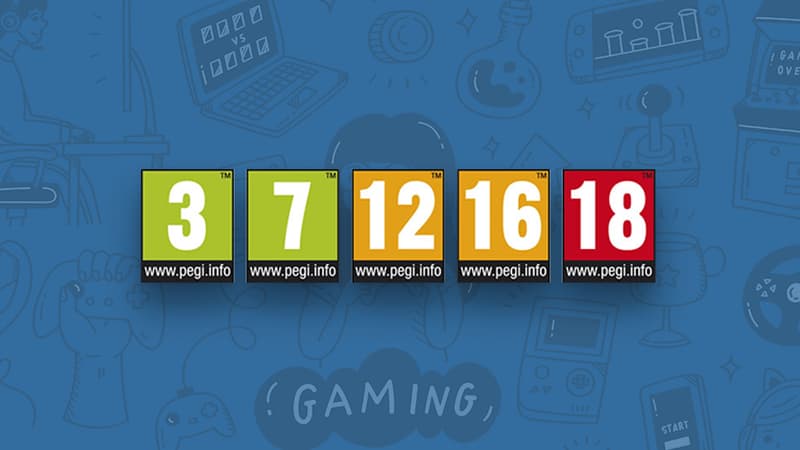PEGI 3, PEGI 7, PEGI 16 or PEGI 18. Many parents have already seen this small logo on video game boxes, often accompanied on the back by multiple icons representing swear words, a heart, drugs, etc.
This is a pictogram illustrating the rating system that lets you know if a game is right for the child it’s intended for. A signaling that wants to be as clear as possible and a mention, now essential, that is not distributed randomly. Because each pictogram not only corresponds to a minimum age to enjoy a game, but also reflects the content, situations and topics that will be discussed or highlighted.
PEGI is not just for kids
The PEGI rating is not just a French specificity. Released in 2003, it means Pan-European Game Information (Pan-European Games Information System) and was created at the initiative of the European Federation of Leisure Software. His goal was to unify the national systems in Europe to have the same reading grid on the back of the game boxes, and now for game cards purchased in dematerialized form, both for PC and console games. Europe supported its creation, designing this system as a child protection tool, approved in France since 2015 by the Ministry of the Interior, which imposes its application for all games sold in the territory.
More than thirty countries have adopted it, multiple players in the video game industry, be they manufacturers (Sony, Microsoft, Nintendo), publishers (Ubisoft, Electronic Arts, Square Enix, etc.) or online stores (Steam, Epic Games Store, GoG.com, etc.).
With the help of different icons, parents can immediately know what are the hot spots in the game. But the PEGI rating does not represent a game difficulty level.
In 2016, an awareness campaign started by SELL, the Recreational Software Publishers Guild, cleverly staged the same situation, but according to its treatment, it was not intended for the same audiences.
You should know that Asia, Brazil (ClassInd), Australia (Classification Board), Germany (USK) and North America (ESRB) have their own classification system. This can sometimes lead to differences in the perception of a game and the age group it is intended for depending on the country. But all the systems are then grouped together within the IARC (International Age Rating Coalition) to assign a common and consistent rating for interactive entertainment products, games and applications.
Mobile games follow a separate logic. They are not officially included in the certification applications, but Google has nevertheless decided to apply the PEGI system to the games presented in its Play Store. Apple, on the other hand, has its own rating that follows the recommendations of PEGI and ESRB (4+, 9+, 12+, 17+)
What are the classifications?
PEGI is divided into five age classes, each with its own pictogram (PEGI 3, PEGI 7, PEGI 12, PEGI 16, PEGI 18). In spirit, regarding the classification of cinematographic or television works, the idea is to give a minimum age requirement for a work. Therefore, everything that is labeled PEGI 18 is reserved for adults.
If a game can sometimes seem very childish when it has the PEGI 7 seal or very violent, but endowed with a simple PEGI 16 to the surprise of the parents, it is because it meets pre-established criteria. Various elements are taken into account in the ranking: drugs, sex, discrimination, violence, fear, profanity, betting and online betting, and since 2018 in-app purchases are also taken into account. Depending on the degree of involvement in the game, the PEGI will be higher or lower. The presence of loot boxes is also mentioned with the phrase “In-app purchases: includes random content” below the pictograms.
-PEGI 3:
It is awarded to games for players of all ages. The main character must be imaginary and not comparable to a real human being. Any act with a violent tendency (knocking down an opponent, shaking them, etc.) is only tolerated in a comical context. No image should scare the player and foul language is not tolerated. So there are games like FIFA 23, Mario Kart
-PEGI 7:
Potentially frightening images, scenes, or sounds are tolerated.
-PEGI 12:
Mild rudeness without sexual insult is tolerated, as well as more graphic violence towards imaginary characters and/or non-graphic violence, but towards more identifiable human or animal characters. Some scenes of light nudity are accepted. The famous simulation game. the sims 4 fall into this category just like online games like world of warcraft Y League of Legends.
-PEGI 16:
Realism begins to take precedence. Depictions of realistic sexual contact or violence are tolerated. The game may also contain more advanced vulgar language, scenes that refer to drugs or tobacco. Games related to player-managed criminal activities are rated at PEGI 16. This is the case for shooting games, like certain titles. Call of Duty or Halo Infinite.
-PEGI 18:
Everything is accepted. Violence, such as scenes of crude sexual depiction and/or the inclusion of specific elements, may be present and cause some players to feel disgusted.
To claim certification for their game, publishers and developers must apply to one of two recognized organizations. NICAM, based in the Netherlands, manages PEGI 3 and PEGI 7 certifications for games. The Video Standard Council (UK) manages PEGI 12, 16 and 18. Both bodies bring together experts, psychologists, academics, video game specialists, but also experts. in law and technology they have to think about the classification of the game.
Source: BFM TV


